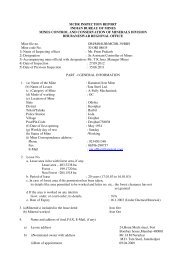Market Survey on Copper - Indian Bureau of Mines
Market Survey on Copper - Indian Bureau of Mines
Market Survey on Copper - Indian Bureau of Mines
Create successful ePaper yourself
Turn your PDF publications into a flip-book with our unique Google optimized e-Paper software.
indicated is a very slow process and that is why it is restricted mainly to l<strong>on</strong>g-term<br />
treatment (3-20 years) <strong>of</strong> oxide/sulphide mine wastes. Nevertheless, large quantity <strong>of</strong><br />
copper is extracted by this l<strong>on</strong>g-term leaching technology. The principal sulphide<br />
minerals in leach dumps are chalcopyrite, chalcocite and pyrite. Pyrite, when leached<br />
c<strong>on</strong>verts to ferric sulphate which c<strong>on</strong>tributes to further leaching <strong>of</strong> copper minerals.<br />
Leaching methods as applied for copper extracti<strong>on</strong> are:<br />
a) In situ leaching<br />
b) Dump/heap leaching<br />
c) Vat leaching/ percolati<strong>on</strong> leaching<br />
d) Agitati<strong>on</strong> leaching<br />
e) Bacterial leaching<br />
a) In situ Leaching: In situ leaching involves the breaking <strong>of</strong> ore in situ<br />
by c<strong>on</strong>venti<strong>on</strong>al mining method. This is practiced for low grade-surface<br />
deposits or worked out underground mines.<br />
b) Dump/Heap Leaching: Dump leaching is applied to the low copper<br />
wastes from c<strong>on</strong>venti<strong>on</strong>al mining methods, usually open pit operati<strong>on</strong>. The<br />
waste rock is built into large dumps and the leachant is sprinkled over the<br />
surface and allowed to trickle down through the dump. Heap leaching is exactly<br />
the same as dump leaching except that surface oxide ore deposits rather than<br />
mine wastes are broken and piled into heaps <strong>of</strong> 1,00,000 to 5,00,000 t<strong>on</strong>nes.<br />
The solid material in the heaps is somewhat smaller (100 mm) than those in the<br />
dumps and leaching is faster. <strong>Copper</strong> recovery from sulphide heaps is low due<br />
to short leaching time (100-180 days). Leaching recovery seldom exceeds 60%.<br />
However, this method requires lowest capital cost.<br />
c) Vat/Percolati<strong>on</strong> Leaching: Vat leaching is a high producti<strong>on</strong> rate<br />
method employing c<strong>on</strong>centrated sulphuric acid to produce a pregnant soluti<strong>on</strong><br />
<strong>of</strong> sufficient copper c<strong>on</strong>centrati<strong>on</strong> for electro-winning from oxidised copper<br />
ores (1.02% Cu). This technique, is based <strong>on</strong> batch principle. The ore crushed<br />
and sized to 10-20 mm c<strong>on</strong>taining no fines or with fines, agglomerated by<br />
moistening and rolling, is leached in large rectangular vats (28 m l<strong>on</strong>g x 15 m<br />
wide x 6 m deep) and is capable <strong>of</strong> treating 3,000 - 5,000 t<strong>on</strong>nes. The leaching<br />
usually takes place in sequence <strong>of</strong> four to seven reinforced c<strong>on</strong>crete vats<br />
arranged side by side. The pregnant soluti<strong>on</strong> from the these vats are used as<br />
electrolyte (after purificati<strong>on</strong>) while the remaining soluti<strong>on</strong> (being more dilute<br />
in copper) is used to leach subsequent fresh batches <strong>of</strong> ore, c<strong>on</strong>tinuous batch<br />
leaching is now being practised in several operati<strong>on</strong>s. The most prominent<br />
example <strong>of</strong> vat leaching has been the Chuquicamata (Chile) plant based <strong>on</strong><br />
sulphate ores (antlerite). Chambishis (Zambia) vat leaching plant was based <strong>on</strong><br />
carb<strong>on</strong>ate copper ore. The total process cycle may last for 100-200 hours and<br />
recovery <strong>of</strong> copper up to 95% is possible from readily soluble oxide copper<br />
ores.<br />
43
















